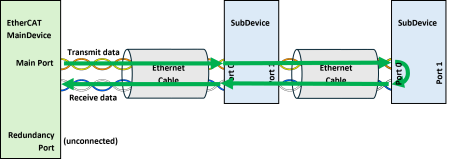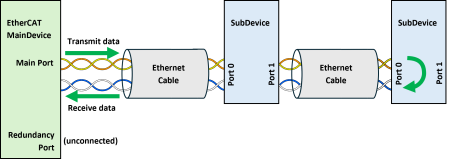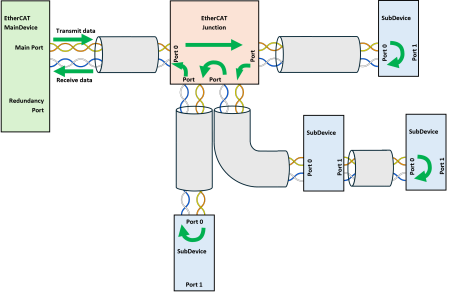
This topic provides a general overview of the physical arrangement of EtherCAT networks.
EtherCAT supports line, ring, star and tree topologies, with the option of cable redundancy. EtherCAT SubDevices always have two or more ports and are typically connected in a line topology. EtherCAT devices are connected together with CAT 5 or better Ethernet cable. RJ45, M12, and M8 connectors are common.
Important! Do not use Ethernet switches!
EtherCAT is not compatible with normal Ethernet. Ethernet switches cannot be used with EtherCAT. Specialized EtherCAT junctions may be used instead, as mentioned in the Star Topology section below.
Related content:
For instructions on initially creating an EtherCAT network, see Creating a New EtherCAT Network.
For instructions on adding, removing, and re-ordering SubDevices in an existing network, see Editing the EtherCAT Topology.
To determine whether and how your physical network differs from the network as configured in RMCTools, use the Network Mismatch Analyzer.
Logical Ring Topology
Whether an EtherCAT network is designed as a line, ring, or star topology, the underlying functionality is always a logical ring topology.
A logical ring topology works as follows: The EtherCAT data is transmitted from the Main Device through one twisted wire pair in an EtherCAT cable. The data frame (packet) travels through all the SubDevices, then, at the last device in the line, returns via the second twisted wire pair in the same cable, passing through all the devices on the way back to the MainDevice. This creates a ring-type functionality within the cable, and is called a logical ring although it doesn’t actually create a cable ring. As the data frame travels through a SubDevice, data is only exchanged if the frame travels into the In port and goes out the Out port. Therefore, as the data frame travels out from the MainDevice, the data in the frame is exchanged to each SubDevice as it passes through. After the frame reaches the last SubDevice and returns, passing through each SubDevice again, the data in the frame is not modified, because it is going into the Out port and out of the In port.

Line Topology
In a line topology, each SubDevice is connected to the previous one.

Port labeling varies by manufacturer. Many SubDevices use the terms In and Out for Port 0 and Port 1, respectively. Some use Port 1 and Port 2, while others use A and B.
It is very important that the Ethernet cable coming from the MainDevice is connected to the In port on the first SubDevice, and that a SubDevice’s Out port is connected to the next SubDevice’s In port.
Ring Topology
A ring topology is similar to the line topology, with the last device connected to the second port of the MainDevice (Redundancy port). During normal operation, the Main Port and Redundancy ports both send out a frame.
When no cable fault exists, the frame from the Main Port passes from the In Port to the Out Port of each SubDevice and the SubDevice exchanges data with the frame. The frame from the Redundancy Port passes from the Out Port to the In Port of each SubDevice and therefore, no data is exchanged (recall from the Logical Ring Topology discussion above the data is only exchanged when the frame enters the In port and exits the Out port).
Note: When connecting a ring topology, the Cable Redundancy setting for the RMC MainDevice must be enabled. This can be set in the EtherCAT Editor, on the MainDevice’s General tab.

If the ring topology experiences a cable break, the MainDevice transmits and receives via both the Main Port and the Redundancy Port. The communication can continue despite the cable break.
When a cable fault exists, the frame from the Main Port passes from the In Port to the Out Port of each SubDevice and the SubDevice exchanges data with the frame, up until the last SubDevice before the cable break, then returns just as in the line topology. The Redundancy port also sends out a frame that passes from the Out Port to the In Port of each SubDevice up until the cable break, then returns. During this return, the data passes from the In Port to the Out Port of each SubDevice and therefore, data is exchanged.

Star Topology
A star topology requires EtherCAT junctions, such as the Beckhoff CU1124 or EK1122. EtherCAT junctions come in varying numbers of ports. The data still operates as a logical ring, with the transmit data sent on the first twisted wire pair and returning on the second twisted wire pair in the same cable. By adding more junctions after junctions, a tree topology is also supported.
The RMC does not support redundancy on star and tree topologies.

See Also
EtherCAT Overview | Creating a New EtherCAT Network | Editing the EtherCAT Topology
Copyright © 2025 Delta Computer Systems, Inc. dba Delta Motion